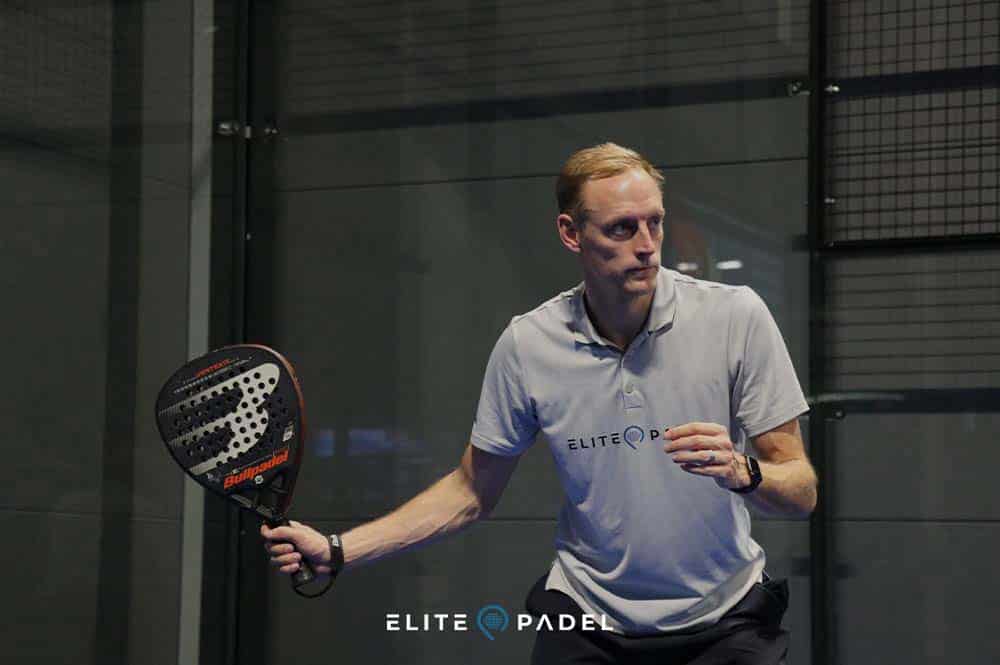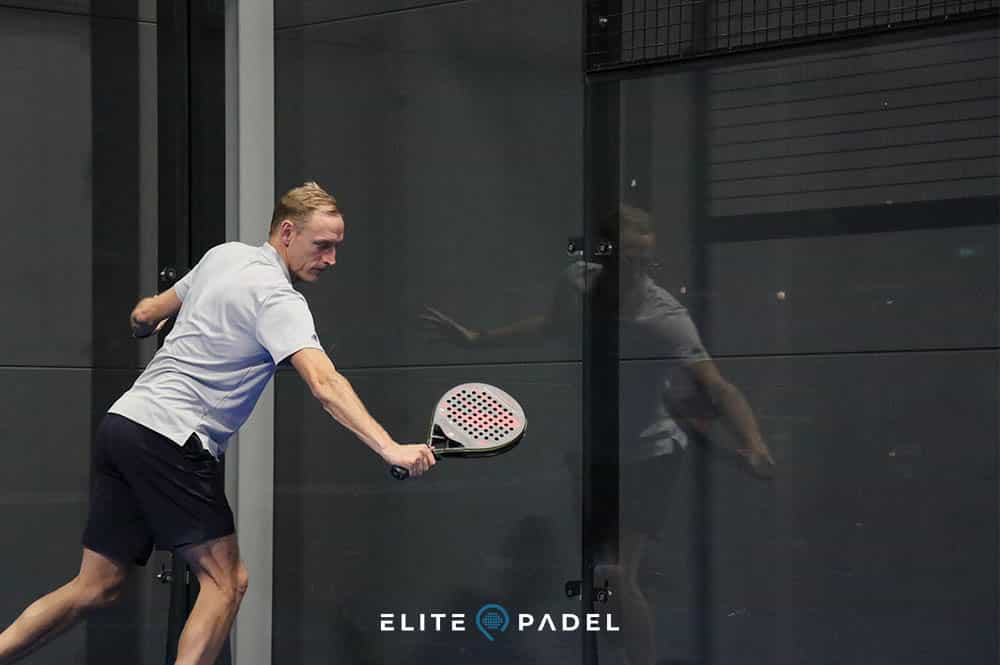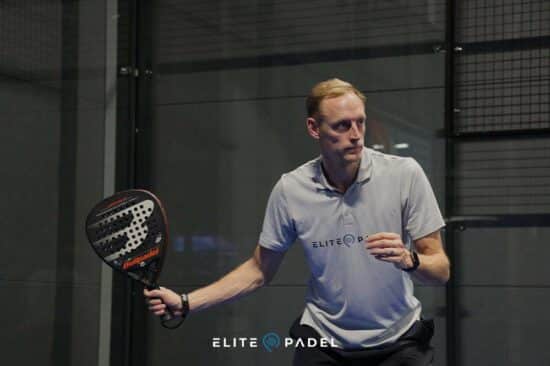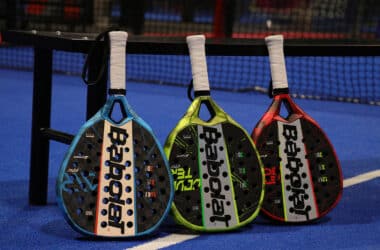Want to improve your forehand and backhand or learn why you should use the strokes? Good – because you’re in the right place!
In this article, we’ll go over the following:
- 3 concrete tips on how to hit a better forehand
- Tips on what to avoid when hitting a forehand
- 3 concrete tips on how to hit a better backhand
- Tips on what to avoid when hitting a backhand
Vamos!
Content of this page
How to perform a forehand in three steps
A forehand in padel is by far the most common stroke in padel. It is one of the most important basic strokes that you need to be sure of in terms of both precision, execution and speed. Below we’ll go through how to execute a good forehand on the padel court.

Setting up for the shot
Let’s start with the basics – a proper grip. The racket should be held in a vertical position with one edge pointing up and the other edge pointing down. Imagine you are “greeting” the racket, keeping it straight. Once you’ve got a good hitting technique down, using either a forehand tilt or a backhand tilt can be an option, but initially, the racket should be kept straight. It is important to angle the wrist so that the racket is at 90 degrees to the forearm. The arm you swing with should be straight, and the knees should always be slightly bent.
Hold your racket lower down when you are further back in the court, and higher up at the front of the net to get to the ball more easily and quickly.
Technique through the stroke
For the sake of simplicity, we explain the technique for a right-handed player; if you are left-handed, just switch to the opposite side. Put your body weight on your right leg, turn your upper body so that your left shoulder is pointing straight ahead, and take a step towards the ball as you strike it. Let your free hand point forward towards the ball. Make sure you hit the ball far forward – ideally level with your knee forward, but at least in front of your left shoulder.
The ball strike is neutral, meaning you don’t need to put any kind of spin or power on the ball. If the ball is coming high, you can choose to use a slice, a backspin for a lower bounce, but concentrate initially on a neutral hit. Common to the basic strokes in padel is that you have a very short backswing, meaning it is important that you hit the ball accurately.
Another option is to have a so-called ‘open stance’, which means that instead of taking a step forward towards the ball at the moment of impact, you remain standing with your legs parallel. Keep in mind that you still have to twist your upper body in the same way and that your body weight must be brought forward when hitting the ball.
The aim of the stroke
The forehand is an extremely important basic stroke in padel, which you need to master in order to take yourself to the next level. You need a good forehand to return your opponent’s serve, to prepare for an attack, and to defend yourself – in short, in any game situation.
Tips to improve your forehand
Below are our top 3 tips on how to improve your forehand and score more points.
1. Practice playing with both an open stance and by stepping into the ball
It’s important that you feel comfortable with both techniques, as they can be appropriate in different situations, and the more strings you have on your lyre the better.
2. Practise the timing of your step towards the ball
You need to find the right rhythm in your forehand stroke. If you take the step a little too early, you will miss the power that comes from your body moving forward. If you take the step too late, you are likely to approach the ball awkwardly and not be able to place the ball where you intended.
3. Rent a court and practice placing your forehands all over the court
What you need to remember is that your swing and movement should be the same at all times and that it’s your feet that should keep you in the right position. Wherever you hit the ball and wherever you want to put it, your movement should look the same.
What to avoid when hitting a forehand in padel
- Avoid hitting with your arm only. You need to twist your upper body to include your shoulder and body rotation in the stroke.
- Always hit the ball in front of your body, if it is too far back you will not get enough power in the stroke.
- Avoid compensating with your swing or wrist, it’s the footwork that should make sure you gain accuracy on the ball.
How to perform a backhand in three steps
The backhand, together with the forehand, are the two most common basic strokes in padel. It is very important that you can handle these strokes to consistently win matches.

Setting up for the shot
As we went through in the forehand stroke, the correct grip is essential, and again the racket should be held in a vertical position with one edge pointing up and the other edge pointing down.
Think of the face of the racket as a knife blade with which you are about to cut. Again, it is important to keep the hitting arm straight and the wrist angled so that the racket is at 90 degrees to the forearm. When it comes to your backhand, you should also have your other hand at the neck of the racket, and it should follow the movement as you make the backswing.
It’s your footwork that should ensure you get to the ball efficiently, so always keep your knees slightly bent with your body weight balanced to make the fastest moves possible.
Technique through the stroke
Bring both arms back in a short swing, making sure to hit the ball in front of the shoulder of the striking arm. Be sure to twist your upper body properly, remember, it’s not about swinging your arm.
When hitting the ball, your free arm should move backward; it should look like you are opening your arms to give someone a hug. Your bodyweight should move forward when you hit. Initially aim for a neutral ball strike with no impact until you feel the technique is there, then take your backhand to the next level by starting to put some backspin on the higher balls.
The aim of the shot
Like the forehand, the backhand is a fundamental stroke that is imperative to dominate your opponents completely. When serving, defending, or preparing to attack closer to the net – a well-executed backhand is the be-all and end-all for a skilled padel player. Whether you prefer a single or double backhand is irrelevant, the important thing is to get the technique right and feel comfortable when hitting.
Tips to improve your backhand
Below are our top 3 tips on how to improve your backhand and score more points.
1. Practice playing with both an open stance and by stepping into the ball
Each technique has its advantage. An open stance with your legs parallel to the net may feel easier for some players, you won’t be as dependent on the timing of your step. However, if you get the hang of stepping forward at the right moment, it will be easier to create a more powerful backhand without having to take much of a hit, as the movement of your body weight will do most of the work.
2. Practice timing your step towards the ball
Good timing is the key to a good backhand. If you find it too complicated, you can prioritize an open stance, but it’s best to be able to handle both variations depending on the situation. You need to find the right flow in your backhand, and make sure you’re always light on your feet.
3. Rent a court and practice placing your backhands all over the court
Practice, practice, and practice again. The basic technique needs to be in your backbone before you embark on more advanced strokes that can expand your record on the court. The technique of your backhand should look exactly the same in all positions wherever you are on the course.
What to avoid when hitting a backhand in padel
- Avoid hitting the ball too far back or too close to your body, as this will prevent you from gaining the necessary momentum and make it difficult to control the ball.
- Be sure to keep your hitting arm as straight as possible, and to keep the racket straight for a flat ball flight. It’s quite easy to accidentally angle the racket upwards, but if the ball goes too high above the net, your opponent will have the upper hand.
- Never keep your body weight on your back leg, as you will lose the power of your stroke.
Want to learn more about padel?
Elitepadel has a series of articles that we call the padel school. Here are examples of more articles:








